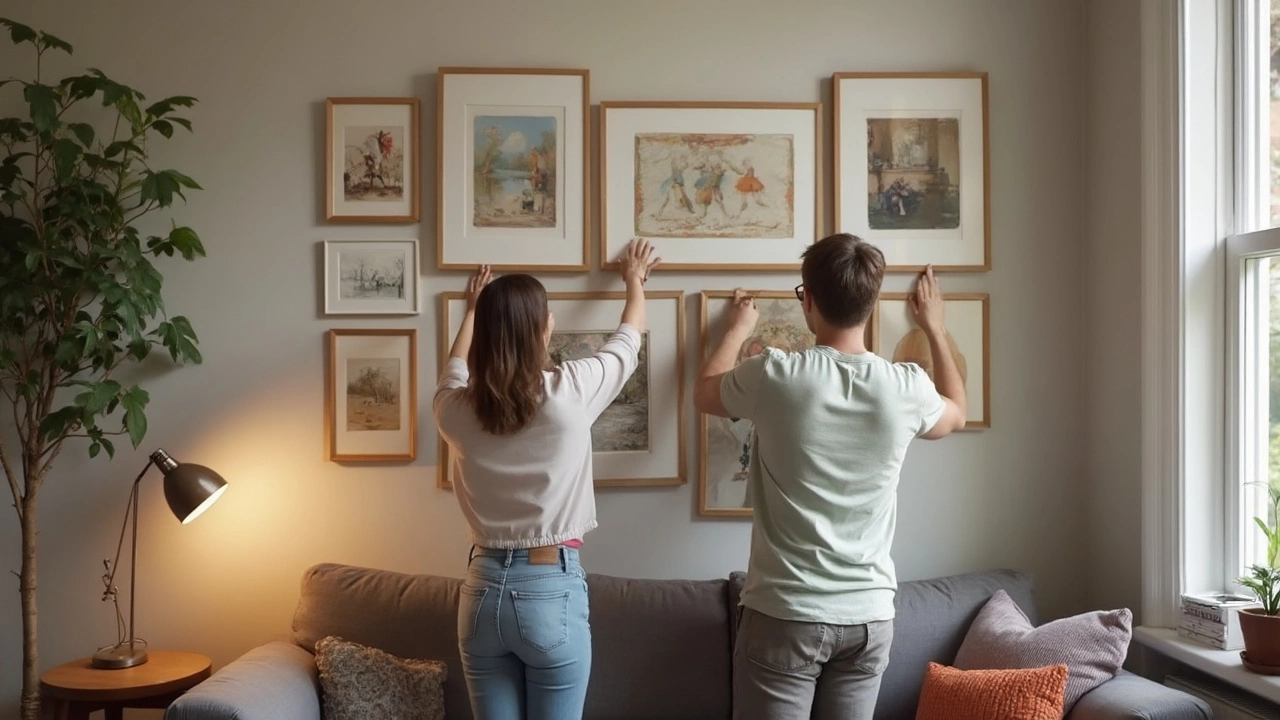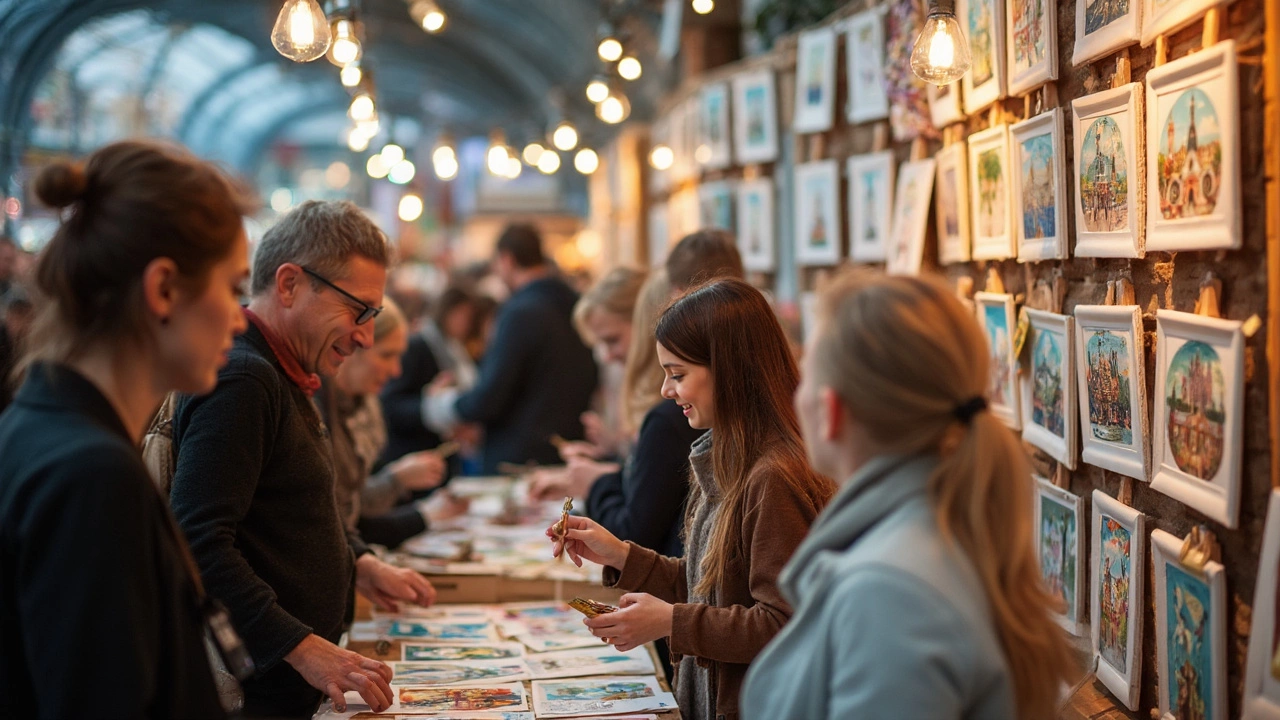Walk into any art fair or scroll through Etsy, and you'll spot a ton of small art prints. What's going on? Are these tiny pieces actually paying the bills for artists?
Small prints can sell surprisingly well, and there's a logic to it. They're affordable, easy to display, and less intimidating than giant canvases—especially for someone who just moved or wants to brighten up a dull corner. Ever notice how much easier it is to impulse-buy a $25 print than a $250 one? That's exactly the point.
Artists who lean into smaller sizes find their audience isn't just art collectors—it's college students, first-time apartment renters, or people hunting for unique gifts. Selling small art prints opens up way more opportunities, both offline and online, because not everyone has the space (or the budget) for big artwork. Plus, little prints are easier and cheaper to ship, which is a huge deal if you’re selling internationally.
- Why Small Prints Work in the Market
- What Buyers Actually Want
- Best Ways to Sell Small Art Prints
- Tips to Make Your Small Prints Irresistible
Why Small Prints Work in the Market
Small art prints are way more than just "entry-level" art. These prints carve out their own space because a lot of folks just don’t have the budget or wall space for big, original pieces. Take a look around—modern apartments keep getting smaller, and so do people’s art needs.
Online shops like Etsy and Society6 have seen a boom in small print sales over the last few years. According to Etsy’s 2023 seller trends report, art prints in the 8x10 inch and smaller range were among their top growth art categories, with sales growing by 22% year-over-year. These numbers aren’t just about lower prices—they show that shoppers genuinely like the flexibility and accessibility of small art.
For a lot of buyers, grabbing a couple of small prints feels more like picking out a new hoodie than making a high-stakes decision. Here’s something interesting from a 2022 interview with Jess Huang, founder of an art print collective:
“Almost half our print customers are first-time art buyers. They’re looking for something personal, but they want it affordable and easy to fit anywhere. Small prints basically let them say yes, right away.”
Let’s put the pros into perspective:
- Lower cost and less risk for new buyers
- Easy to ship (even worldwide) and store
- Works as impulse-buy gifts—especially around holidays
- Encourages repeat purchases (people often buy sets or come back for more)
Check out these real numbers from Etsy’s marketplace:
| Print Size | Avg. Sale Price (USD) | 2023 Units Sold |
|---|---|---|
| 5x7 inches | $12 | 180,000 |
| 8x10 inches | $18 | 200,000 |
| 11x14 inches | $26 | 75,000 |
Notice how the smaller prints not only sell for less, but also rack up way more sales. That’s why if you’re planning to break into art sales, focusing on small art prints can put you in front of folks who love art but aren’t ready to drop serious cash—or just don’t have space for a museum-sized piece.
What Buyers Actually Want
If you hang around online marketplaces or talk to folks at art fairs, you’ll notice buyers have some clear preferences when it comes to small art prints. First up: budget matters. Most people aren’t looking to break the bank, so prints priced from $15 to $40 move fastest. That sweet spot attracts everyone from broke college kids to office workers who want to decorate their cubicle.
Convenience is another big one. People love prints they don’t have to custom frame, so 8x10 inches or A4 sizes are way more popular since you can grab a frame from IKEA or Target. Ready-to-hang prints or those that come with matting usually end up in shopping carts quicker—no hassle, just instant decoration.
For gift-buyers, small prints are gold. They’re easy to mail, easy to wrap, and nobody worries about wrecking their wall trying to hang some massive piece of art. Sometimes, people even buy two or three prints to make a little gallery wall—so bundles and themed sets really catch attention.
Here are some features buyers rave about:
- Affordable price points
- Standard sizes that fit store-bought frames
- Unique designs, not found at big chains
- High print quality (think archival paper and sharp colors)
- Signed or numbered editions for that special touch
If you want the cold, hard numbers, check this out. In 2023, Etsy’s annual seller report noted that nearly 67% of art print transactions were for prints smaller than 11x17 inches. That’s not just a fluke—small prints really move.
| Print Size | Average Sale Volume (per 100 sales) | Top Buyer Demographic |
|---|---|---|
| 8x10 inches | 44 | Millennials, Gift-shoppers |
| 5x7 inches | 23 | Students, First-time buyers |
| 11x14 inches | 18 | Office Decorators |
| Larger than 11x14 | 15 | Collectors, Return buyers |
Bottom line: Buyers want small prints because they’re small art prints—easy to handle, easy to love, and they make buying art a no-brainer.

Best Ways to Sell Small Art Prints
Trying to figure out the best way to actually make money with small art prints? You’ve got options, and some are easier to break into than you might think. Here’s what works in 2025:
- Online Marketplaces: Places like Etsy, Redbubble, and Society6 are packed with buyers looking for small, affordable wall art. In 2024, Etsy reported more than 85 million active buyers, and “mini print” searches spiked during back-to-school and holiday seasons. It’s a crowded space, but standing out with unique designs or themes works.
- Personal Websites: Having your own site with e-commerce makes you look legit and keeps your profit margins better since you dodge marketplace fees. Use Shopify or Squarespace—they’re both user-friendly, so you don’t need to know how to code. Embed a simple print-on-demand service if you want to skip packaging and shipping.
- Art Fairs and Local Markets: These events are still gold. According to a 2023 survey by Art Fair Insiders, nearly 60% of artists selling at fairs reported that small prints (8x10 inches or less) made up the bulk of their sales. Pack your booth with eye-catching displays and small, lower-priced prints at the front to grab impulse buyers.
- Social Media Shops: Instagram and Facebook now let you add shop features. People can spot your print in a Reel or Story and buy right away without even leaving the app. Keep your feed real—show prints in real rooms, not just on a blank background.
Here’s a quick look at how artists say they sell the most small prints (data pulled from a 2024 poll of 120 indie artists):
| Channel | % of Artists Who Sell Most Here | Pros | Cons |
|---|---|---|---|
| Etsy | 44% | Huge audience, simple setup | Fees, lots of competition |
| Personal website | 22% | Better profit, brand control | Harder to get traffic |
| Art fairs/markets | 20% | In-person connection, cash sales | Weather, booth fees |
| Social media shops | 14% | Impulse buys, easy sharing | Tricky algorithms |
Quick tip: stack your options. Don’t just set up one shop and cross your fingers. Most artists get their best results by combining online with in-person sales, keeping their reach and cash flow steady even when one channel is slow.
Tips to Make Your Small Prints Irresistible
The difference between small art prints that sit in your shop for months and ones that sell out comes down to more than just good art. Small changes in how you present, price, and market your prints can completely change the game.
- Quality matters way more than you think. People expect the same richness in a 5x7 print as a huge one. Use thick, archival paper. Make sure your prints are color-accurate—cheap home printers often kill the vibe. Print shops like Printful and INPRNT make a big difference here.
- Don't ignore the packaging. When someone is buying a $15 or $20 print, a branded sticker, rigid mailer, and a handwritten thank you make it feel special. Over 50% of repeat buyers on Etsy mention good packaging in their reviews.
- Photos sell your art. Show prints in a real setting, like taped to a wall, on a desk, or even clipped to a fridge. This helps buyers picture how easy it’d be to add your work to their space. No need for a fancy setup—natural light and a clean background work wonders.
- Pricing is key. Underpricing can make people question quality, but going too high for a small print kills impulse buys. Research similar items on Etsy, Society6, and Redbubble. Most successful artists keep small prints between $12 and $30, depending on size and paper.
- Bundle deals work. Offer sets at a discount (like three prints for $35) or include a free mini print with two purchases. Bundles push people to buy more without feeling like they’re splurging.
Social proof helps. Share customer photos and reviews on your product listings and Instagram. As printmaker Tyler Feder puts it,
"People love seeing where your art ends up—those customer photos are honestly better ads than anything you could post yourself."
Stay consistent with the style and vibes of your collection. When people see a row of your prints side-by-side, they should feel like they belong together. This doesn’t mean you copy yourself, but make sure colors and themes make sense as a set.
The small things add up. Nail these steps, and your small art prints can punch way above their weight when it comes to turning browsers into buyers.





